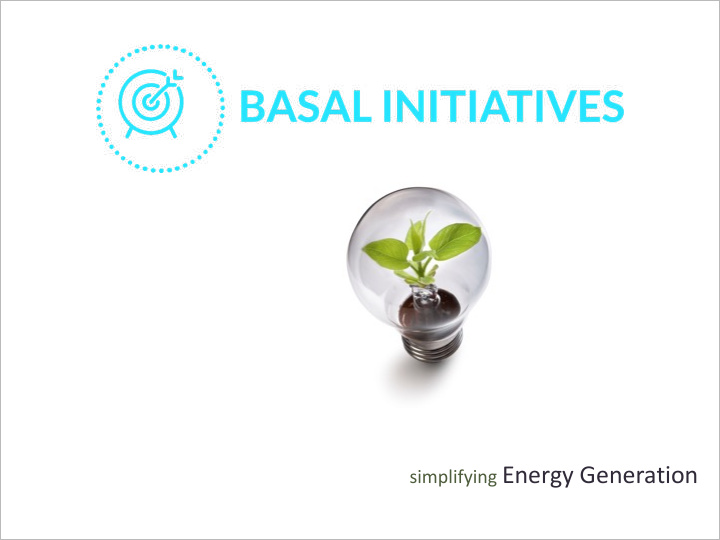



“Driving Revenue – Decreasing Profits” simplifying Energy Generation 1
BI is a leader in the Waste to Energy (WtE) space BI Energy Hazardous Material MSW Animal Manure Tires Biomass Basal Initiatives (P) Ltd is commercializing proprietary solutions to convert carbon based waste feedstock to energy 2
BI solutions for Public and Private Sector Projects. BI’s portable, modular 1.25mWh unit converts waste to energy for public and private sector applications. These includes utility, industrial, agricultural and residential applications. 3
History of D4 Energy Group Our Partner ❑ Technology R&D completed over a 12 year period with an emphasis on tires, MSW and biomass. Two half scale pilot units and one production scale system developed and operated. ❑ Incorporated in 2009 to commercialize technology. ❑ Current version tested more than 1,000 hours with multiple types of MSW and biomass feedstocks. ❑ Independent energy and mass balance demonstrated that a D4 unit will: ▪ Convert on average 80% of feedstock to gas and 20% to carbon ▪ Produce syngas with a caloric content of from 600 to 750 BTU ▪ Resulting in 1.25 mWh of electricity from 30 tons of processed feedstock ❑ In November 2011, first commercial system shipped to a customer in Wadowice, Poland. 4
Waste-to-Energy Industry Overview - Increasing waste generation from population growth and urbanization Limited landfill capacity and a need for environmentally sustainable waste disposal - Fossil fuels are a major contributor to climate change and the supply side grows increasingly risky with mounting instability. 5
Waste-to-Energy Industry Overview (USA) The USA produces more than 254 Million Tons of MSW each year. ● 6
Key Economics customer economics: ➢ CAPEX ($4.5 million/MW) ➢ IRR – Minimum of 18% ➢ ROI – Avg. 50 – 60 Months ➢ The IRR/ROI includes NO tax or carbon credits, subsidies, etc. This is a full production unit capable of producing 1.25 mWh 7
A Sustainable Advantage Benefit Description High waste stream conversion rates Approximately 80% of feedstock is converted to syngas and 20% to carbon Medium BTU values D4 units produce on average 600 to 750 BTU gas Efficient processing A small amount of the gas produced (approx. 15%) is used to run the D4 units and make the process self-sustaining Zero emissions D4 units operates as a closed loop system that create no emissions in processing of the feedstock Modularity and scalability Systems start as small as 1.25 MW (30 tons/day) and grow as large as 40 MW (1,000 tons/day) Low investment threshold $5.5 million for a single D4 node vs. hundreds of millions for various other technologies Lower capital costs $550 per annual processed ton vs., for example, $2,000 per processed ton for mass burn incinerators Lower operating costs Driven by modular configuration, simpler design, and operation at a single atmospheric pressure High return on investment Minimum IRR of 20% with an average 50 to 60 month payback period Flexible feedstocks Accepts a wide variety of waste streams and/or biomass Greenhouse gas reduction Reduces landfill methane and reliance upon fossil fuels Fast installation Can be delivered, assembled, and making energy in as fast as four weeks Portability Can be disassembled and moved to other sites 8
Strong Competitive Differentiators 9
The Science Process: Proprietary technology built upon the proven sciences of pyrolysis (devolatization in an inert atmosphere) and hydropyrolysis (devolatization in a hydrogen-rich atmosphere). Output - Gas: Syngas (600 - 750 Btu). Used for power production or used directly for industrial purposes . Output - Carbon: Can be sold for soil amendments, fuel sources, fillers for rubber, plastic applications, filtration, and road construction additives. Emissions – Equal to natural gas but no emissions in the conversion from waste to gas. 10
From Single 1.25MW Systems … 11
… to multiple node systems ❑ Sample 10 node (12.5MW) system 12
Complete range of D4/BI professional services ❑ Complete systems integration and installation ❑ Training on operations, maintenance and safety ❑ 24/7 Technical Assistance Center ❑ Warranty support programs ❑ Spare part programs ❑ Ongoing education and safety certification 13
Future of D4/BI Proprietary and Innovative Future of D4 Proprietary and Innovative Technology Mobile Unit Liquefaction D4 energy will be bringing to market a mobile expeditionary energy system D4 Energy will be bringing to consisting of 3 – 4 theater hardened market a liquefaction technology tractor/trailer units that from time on capable of taking carbon from our site to making energy will be 4 hours. current technology and producing This system is being designed for a high quality diesel fuel/JP8. Each Defense and Emergency Response/ unit will produce approximately 4 Disaster Recovery. million gallons per year 14
Recommend
More recommend